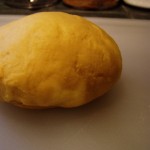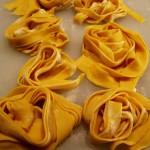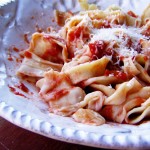


Pasta is one of my absolute favorite foods. It can support an incredible variety of supporting actors, from the simple (butter and cheese) to the elegant (vodka sauce) to the bizarre (tomato juice – really, my step-sisters love it this way). It’s easy to store and is generally pretty cheap.
But why fresh pasta? If you don’t already know, I think any explanation I could give you would be woefully inadequate. Imagine trying to explain to someone why cold water is refreshing or that the tops of babies’ heads smell good. If you love fresh pasta and have shied away from making your own because you think you can’t, give it a go. It’s not an especially quick process, although I have successfully pulled this off on a weeknight when I came home on the daylight side of 7pm.
Like so many things in life, there are two ways to do this: the easy way, and the hard way. The hard way is not impossible by any means (and I have successfully tackled it many times), it’s just a little messier and requires more elbow grease than the easy way. However, in terms of tools, the easy way requires a food processor and the hard way requires a flat working surface you don’t mind covering with flour.
I should point out that you also need attire you don’t mind covering with flour. Don’t try to roll fresh pasta in front of your dinner guests if you don’t want them to see you turn into a freshly flocked version of yourself. There are some menus you can easily throw together in dressy duds; this ain’t it.
I use a pasta roller to get the sheets nice and flat, but I typically cut them into tagliatelle by hand with a pizza cutter rather than use the cutting attachment. One of these days, I’ll give fettuccine another shot. For now, the wide, flat ribbons of tagliatelle are perfect. Wider pasta can stand up to a very hefty sauce. That is not to say that there is anything remotely weak sauce about cappellini, spaghetti, or the like, but something wide like tagliatelle is really your ticket if you make, say, a hearty ragout.
You will note that I let the dough rest for 2 hours. You can speed it up, if you wish, but some rest is critical – at least 20 minutes. This lets the flour form gluten, which will make your dough elastic and lovely instead of sticky and crappy. If you make your pasta on the weekend, as I typically do, give it your best love and kisses and let it have its full nap. If you want to speed the play for weeknight carbtasticness, go with a 20 minute rest (during which time you can make a nice, quick sauce!).
A note on ingredients: I use all-purpose flour for my pasta. Specifically, I use King Arthur All-Purpose – comes in a red and white bag. After years of playing hit and miss with many flour brands, I have come to love King Arthur. I use their bread flour, wheat flour, and all-purpose flour (often referred to here as “AP flour”). Yes, you can do lovely things with fancier flours, particularly semolina. I just haven’t gotten around to trying. When I do, I will keep you updated. In the meantime, I like this recipe as I always have the components on hand. AP flour? Check. Eggs? Check. You can have a spectacularly bare fridge and still knock your own socks off with the simplest of ingredients. Try it.